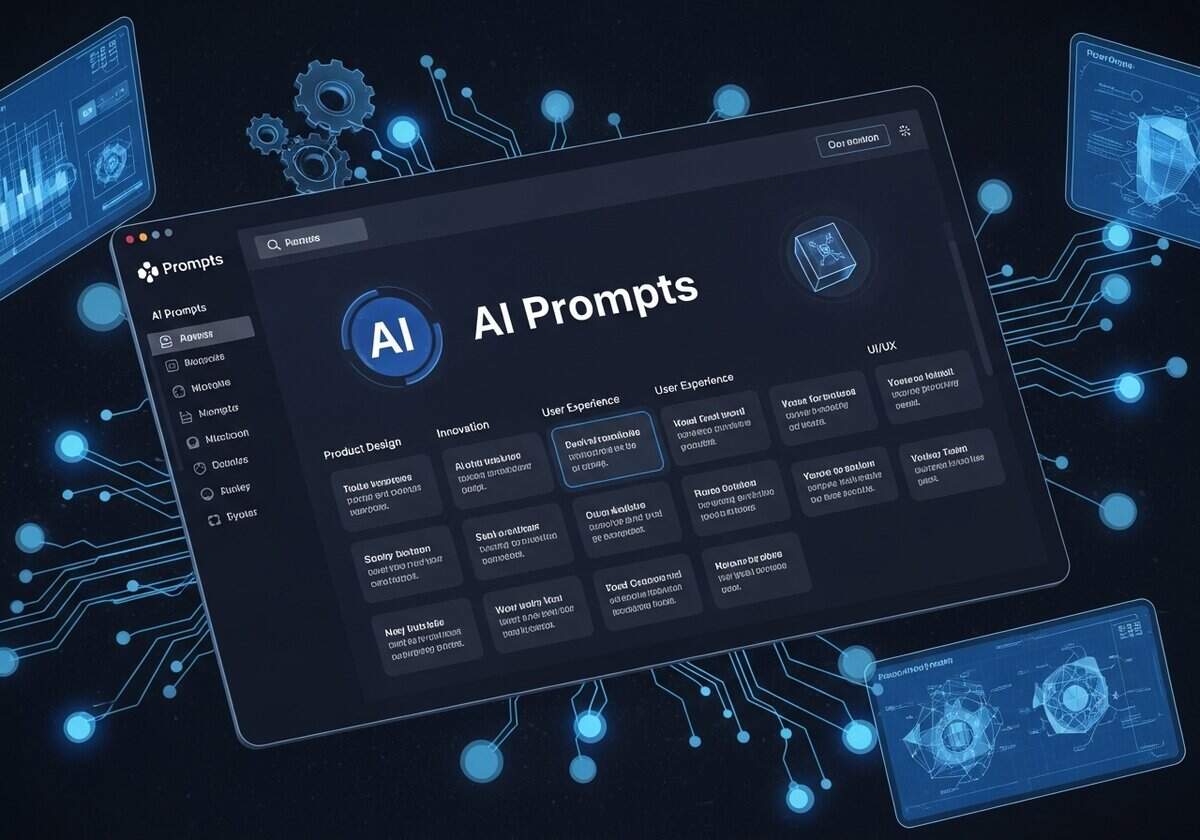Einfach das größte Verzeichnis für KI-Eingabeaufforderungen, spezialisiert auf Produktdesign und Innovation

Willkommen beim weltweit größten Verzeichnis für KI-Anweisungen, das sich mit fortschrittlichem Produktdesign, Technik, Wissenschaft, Innovation, Qualität und Fertigung befasst. Während Online-KI-Tools die technische Landschaft durch die Erweiterung menschlicher Fähigkeiten rapide verändern, entfalten sie ihre wahre Stärke erst durch präzise und fachmännisch ausgearbeitete Anweisungen. In diesem umfassenden Verzeichnis finden Sie eine Sammlung solcher Anweisungen, die es Ihnen ermöglichen, KI-Systeme zu steuern, die große Datenmengen verarbeiten, komplexe Muster erkennen und neue Lösungen weitaus effizienter als herkömmliche Methoden entwickeln können.
Entdecken Sie die exakten Eingabeaufforderungen, die Sie benötigen, um KI-Agenten für die Optimierung Ihrer Entwürfe im Hinblick auf Spitzenleistung und Herstellbarkeit, die Beschleunigung komplexer Simulationen, die genaue Vorhersage von Materialeigenschaften und die Automatisierung einer Vielzahl wichtiger Analyseaufgaben zu nutzen, und stimmen Sie diese ab.
Die erweiterten Suchfilter ermöglichen einen schnellen Zugriff auf dieses umfangreiche Verzeichnis und decken das gesamte Spektrum der modernen Technik ab.
Angesichts der Server-Ressourcen und des Zeitaufwands sind die Eingabeaufforderungen selbst nur registrierten Mitgliedern vorbehalten und unten nicht sichtbar, wenn Sie nicht angemeldet sind. Sie können sich registrieren, 100% kostenlos:
Mitgliedschaft erforderlich
Sie müssen Mitglied sein, um auf diesen Inhalt zugreifen zu können.
- Hypothesenbildung
AI Aufforderung an Hypothesize Causes of Catalyst Deactivation
- Chemisches Recycling, Analyse des Versagens, Werkstoffkunde, Prozessverbesserung, Qualitätskontrolle, Qualitätsmanagement, Ursachenanalyse, Nachhaltigkeitspraktiken
This prompt generates plausible hypotheses explaining catalyst deactivation based on a list of observed symptoms such as activity loss, selectivity change, and physical catalyst changes. The AI provides a ranked list of hypotheses with brief mechanistic explanations.
Ausgabe:
- Markdown
- erfordert kein Live-Internet
- Fields: {list_of_symptoms}
- Best for: Generate mechanistic explanations for catalyst failures
- Codegenerierung und Fehlersuche
AI Aufforderung an Generate C++ Code for Heat Exchanger Design
- Design für die Fertigung (DfM), Energie, Umwelttechnik, Strömungsmechanik, Wärmebehandlung, Maschinenbau, Prozess-Optimierung, Nachhaltigkeitspraktiken, Thermodynamik
This prompt generates a C++ program to calculate heat exchanger parameters such as heat transfer rate, log mean temperature difference, and required surface area based on user inputs of fluid temperatures, flow rates, and heat capacities. The code is fully commented and ready for compilation.
Ausgabe:
- C
- erfordert kein Live-Internet
- Fields: {inlet_temp_hot} {outlet_temp_hot} {inlet_temp_cold} {flow_rate_hot}
- Best for: Automate heat exchanger design calculations
- Codegenerierung und Fehlersuche
AI Aufforderung an Generate Python Code for Reaction Rate Calculation
- Chemisches Recycling, Chemie, Umwelttechnik, Umweltauswirkungen, Prozess-Optimierung, Produktentwicklung, Qualitätsmanagement, Nachhaltigkeitspraktiken, Thermodynamik
This prompt creates a Python script to calculate reaction rates based on Arrhenius kinetics, given user inputs of activation energy, pre-exponential factor, temperature, and concentration. The code includes comments and example usage, facilitating integration into chemical engineering workflows.
Ausgabe:
- Python
- erfordert kein Live-Internet
- Fields: {activation_energy} {pre_exponential_factor} {temperature} {concentration}
- Best for: Generate reusable code for kinetic calculations
- Datengenerierung oder -erweiterung
AI Aufforderung an Create Catalyst Property Variations
- Design für additive Fertigung (DfAM), Maschinelles Lernen, Algorithmen für die vorausschauende Wartung, Prozessverbesserung, Qualitätsmanagement, Statistische Analyse, Nachhaltigkeitspraktiken, Nachhaltiges Produktdesign
This prompt generates plausible variations of catalyst property data given an initial dataset in CSV format. It outputs an augmented CSV with new catalyst entries created by applying small random perturbations to surface area, pore volume, and metal loading, useful for training robust machine learning models.
Ausgabe:
- CSV
- erfordert kein Live-Internet
- Fields: {catalyst_properties_csv}
- Best for: Expand catalyst datasets to improve model robustness
- Extraktion von Informationen
AI Aufforderung an Retrieve Safety and Hazard Statements
- Chemisches Recycling, Umweltauswirkungen, Umweltverträglichkeitsprüfung, Gefahren- und Betriebsfähigkeitsstudie (HAZOP), Prozessverbesserung, Risikoanalyse, Risikomanagement, Sicherheit
This prompt scans a provided chemical process description or material safety document to extract all safety and hazard statements, including precautionary measures and hazard codes. The output is a bullet-point list in plain text for easy review and compliance checks.
Ausgabe:
- Text
- erfordert kein Live-Internet
- Fields: {process_description}
- Best for: Rapidly gather safety and hazard info from process descriptions
- Extraktion von Informationen
AI Aufforderung an Identify Catalyst Types and Properties
- Chemisches Recycling, Umweltauswirkungen, Umwelttechnologien, Materialien, Prozess-Optimierung, Produktentwicklung, Qualitätsmanagement, Nachhaltigkeitspraktiken
This prompt identifies all catalyst types mentioned in a given technical document excerpt and extracts their key properties such as surface area, pore volume, and active metal loading. The AI outputs a neatly formatted markdown table listing each catalyst and its properties to facilitate catalyst comparison and selection.
Ausgabe:
- Markdown
- erfordert kein Live-Internet
- Fields: {technical_text}
- Best for: Quickly compare catalysts and their characteristics from technical documents
- Extraktion von Informationen
AI Aufforderung an Extract Experimental Parameters from Text
- Chemisches Recycling, Chemie, Umweltauswirkungen, Umwelttechnologien, Prozessverbesserung, Qualitätsmanagement, Forschung und Entwicklung, Nachhaltigkeitspraktiken
This prompt extracts key experimental parameters such as temperature, pressure, catalyst type, and reaction time from a provided unstructured text excerpt of a chemical engineering report or paper. It outputs a structured JSON summarizing each parameter with its value and units, helping engineers quickly gather critical data without manual reading.
Ausgabe:
- JSON
- erfordert kein Live-Internet
- Fields: {unstructured_text}
- Best for: Extracting precise experimental values from unstructured text for quick parameter overview
- Fehlersuche und Diagnostik
AI Aufforderung an Troubleshoot Packed Column Flooding
- Chemisches Recycling, Strömungsmechanik, Prozessverbesserung, Prozess-Optimierung, Qualitätssicherung, Qualitätskontrolle, Risikomanagement, Nachhaltigkeitspraktiken
A packed distillation or absorption column is experiencing flooding. Given column internals packing type fluid properties (gas/liquid loads) operating conditions and observed symptoms (e.g. high pressure drop entrainment poor separation) this prompt asks the AI to suggest causes and diagnostic checks.
Ausgabe:
- Markdown
- erfordert kein Live-Internet
- Fields: {column_service_and_type} {packing_details} {fluid_properties_and_loads_summary} {flooding_symptoms_csv}
- Best for: Guiding chemical engineers in diagnosing flooding in packed columns by systematically linking observed symptoms (high dP entrainment poor separation) to potential hydraulic issues maldistribution packing problems or foaming based on operational data and system design.
- Datengenerierung oder -erweiterung
AI Aufforderung an Simulate Reactor SteadyState Yields
- Chemisches Recycling, Chemie, Design für additive Fertigung (DfAM), Design für die Fertigung (DfM), Prozessverbesserung, Prozess-Optimierung, Simulation, Nachhaltigkeitspraktiken, Nachhaltiges Produktdesign
This prompt generates a conceptual table of expected product yields from a specified chemical reactor type under varying steady-state operating conditions (e.g. temperature pressure catalyst concentration). It relies on general chemical engineering principles and user-provided qualitative impact of conditions. This is for conceptual design or educational exploration not rigorous simulation.
Ausgabe:
- Markdown
- erfordert kein Live-Internet
- Fields: {reactor_type} {reaction_stoichiometry_and_kinetics_qualitative} {conditions_to_vary_json} {base_yield_percent}
- Best for: Facilitating conceptual exploration of process variable impacts on reactor yield providing a basis for preliminary design discussions experimental planning or educational examples without needing complex simulation software.
- Extraktion von Informationen
AI Aufforderung an Extract Catalyst Performance Data URL
- Chemisches Recycling, Chemie, Umwelttechnik, Umweltauswirkungen, Werkstoffkunde, Prozess-Optimierung, Forschung und Entwicklung, Nachhaltigkeitspraktiken
This prompt tasks the AI with scraping a given URL of a research article or patent that discusses catalysis. It should identify and extract specific data related to catalyst performance such as conversion selectivity turnover number (TON) turnover frequency (TOF) and reaction conditions under which these were achieved for a named catalyst or reaction system. The output is a JSON object.
Ausgabe:
- JSON
- erfordert Live-Internet
- Fields: {document_URL} {catalyst_name_or_system} {performance_metrics_list}
- Best for: Efficiently gathering catalyst performance data (conversion selectivity TOF/TON) and associated reaction conditions from online scientific publications or patents aiding in catalyst research and comparative studies.

































Diskutiert niemand über die mögliche Voreingenommenheit bei der KI-Auswahl für diese Verzeichnisse? KI ist nicht immun gegen Vorurteile, Leute.